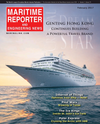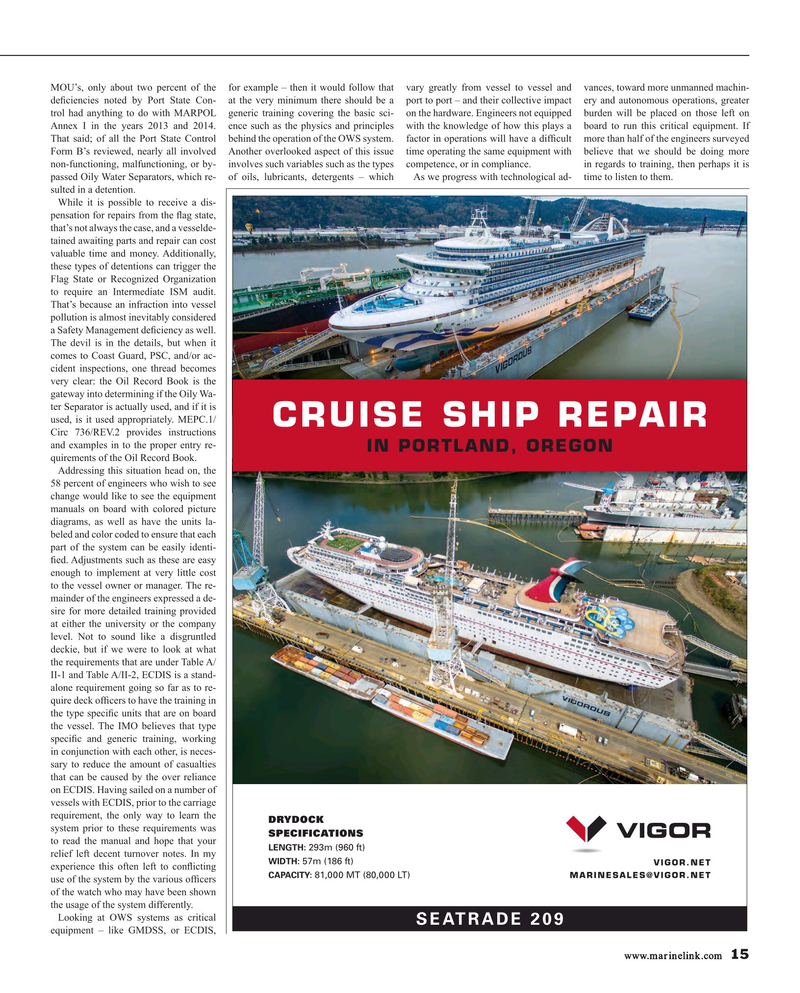
Page 15: of Maritime Reporter Magazine (February 2017)
The Cruise Industry Edition
Read this page in Pdf, Flash or Html5 edition of February 2017 Maritime Reporter Magazine
MOU’s, only about two percent of the for example – then it would follow that vary greatly from vessel to vessel and vances, toward more unmanned machin- de? ciencies noted by Port State Con- at the very minimum there should be a port to port – and their collective impact ery and autonomous operations, greater trol had anything to do with MARPOL generic training covering the basic sci- on the hardware. Engineers not equipped burden will be placed on those left on
Annex I in the years 2013 and 2014. ence such as the physics and principles with the knowledge of how this plays a board to run this critical equipment. If
That said; of all the Port State Control behind the operation of the OWS system. factor in operations will have a dif? cult more than half of the engineers surveyed
Form B’s reviewed, nearly all involved Another overlooked aspect of this issue time operating the same equipment with believe that we should be doing more non-functioning, malfunctioning, or by- involves such variables such as the types competence, or in compliance. in regards to training, then perhaps it is passed Oily Water Separators, which re- of oils, lubricants, detergents – which As we progress with technological ad- time to listen to them. sulted in a detention.
While it is possible to receive a dis- pensation for repairs from the ? ag state, that’s not always the case, and a vesselde- tained awaiting parts and repair can cost valuable time and money. Additionally, these types of detentions can trigger the
Flag State or Recognized Organization to require an Intermediate ISM audit.
That’s because an infraction into vessel pollution is almost inevitably considered a Safety Management de? ciency as well.
The devil is in the details, but when it comes to Coast Guard, PSC, and/or ac- cident inspections, one thread becomes very clear: the Oil Record Book is the gateway into determining if the Oily Wa- ter Separator is actually used, and if it is used, is it used appropriately. MEPC.1/
CRUISE SHIP REPAIR
Circ 736/REV.2 provides instructions and examples in to the proper entry re-
IN PORTLAND, OREGON quirements of the Oil Record Book.
Addressing this situation head on, the 58 percent of engineers who wish to see change would like to see the equipment manuals on board with colored picture diagrams, as well as have the units la- beled and color coded to ensure that each part of the system can be easily identi- ? ed. Adjustments such as these are easy enough to implement at very little cost to the vessel owner or manager. The re- mainder of the engineers expressed a de- sire for more detailed training provided at either the university or the company level. Not to sound like a disgruntled deckie, but if we were to look at what the requirements that are under Table A/
II-1 and Table A/II-2, ECDIS is a stand- alone requirement going so far as to re- quire deck of? cers to have the training in the type speci? c units that are on board the vessel. The IMO believes that type speci? c and generic training, working in conjunction with each other, is neces- sary to reduce the amount of casualties that can be caused by the over reliance on ECDIS. Having sailed on a number of vessels with ECDIS, prior to the carriage requirement, the only way to learn the
DRYDOCK system prior to these requirements was
SPECIFICATIONS to read the manual and hope that your
LENGTH: 293m (960 ft) relief left decent turnover notes. In my
WIDTH: 57m (186 ft)
VIGOR.NET experience this often left to con? icting
CAPACITY: 81,000 MT (80,000 LT)
[email protected] use of the system by the various of? cers of the watch who may have been shown the usage of the system differently.
Looking at OWS systems as critical
SEATRADE 209 equipment – like GMDSS, or ECDIS, www.marinelink.com 15
MR #2 (10-17).indd 15 MR #2 (10-17).indd 15 2/6/2017 9:47:52 AM2/6/2017 9:47:52 AM

 14
14

 16
16
